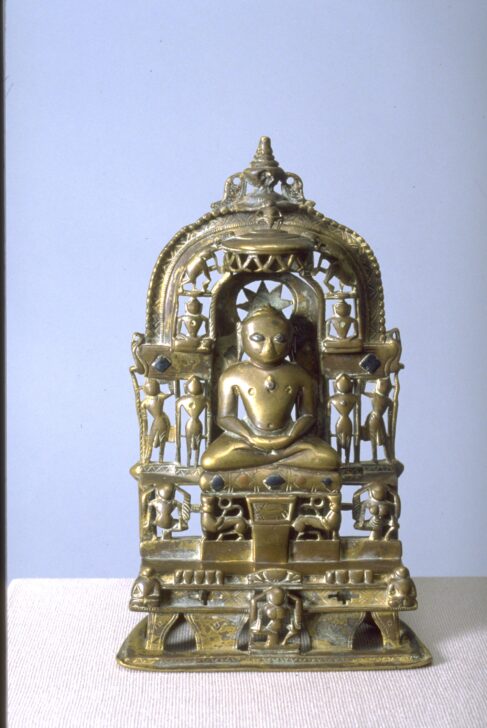Malli shrine, dated VS 1528 [1471 A.D.]
Indian

Description
March 28, 2009
This brass shrine devoted to the Jina Malli reveals several sophisticated metalworking techniques. Evidence suggests that Jain worshipers may have been leaders in the development of metal icons. Unlike Hindus and Buddhists, Jain devotees seem to have avoided clay and ivory because of their strong aversion to killing. The former would require destroying insects and micro-organisms, while the latter involves slaughter of elephants. Here, Malli (nineteenth of the twenty-four Jain tirthankaras, or perfected beings) sits on an elaborate latticework throne composed of myriad cut-out figures in seated and standing postures. Diamond-shaped copper and silver inlay decorates the shrine’s architectural matrix.
(Label for UMMA South and Southeast Asia Gallery Opening Rotation, March 2009)
---
Evidence suggests that Jain worshipers may have been leaders in the development of metal icons. Unlike Hindus and Buddhists, Jain devotees seem to have avoided clay and ivory because of their strong aversion to killing. The former would require destroying insects and microorganisms, while the latter involves the slaughter of elephants. This brass shrine devoted to the Jina Malli reveals several sophisticated metalworking techniques. Malli (nineteenth of the twenty-four Jain tirthankaras, or perfected beings) sits on an elaborate latticework throne composed of myriad cutout figures in seated and standing postures. Diamond-shaped copper and silver inlay decorates the shrine’s architectural matrix.
(South and Southeast Asia Gallery Rotation, Fall 2010)
Gallery Rotation Fall 2010
Malli shrine
India, Gujarat
1471
Brass with copper and silver inlay
Gift of Dr. and Mrs. Leo S. Figiel and Dr. and Mrs. Steven J. Figiel, 1975/2.121
Evidence suggests that Jain worshipers may have been leaders in the development of metal icons. Unlike Hindus and Buddhists, Jain devotees seem to have avoided clay and ivory because of their strong aversion to killing. The former would require destroying insects and microorganisms, while the latter involves the slaughter of elephants. This brass shrine devoted to the Jina Malli reveals several sophisticated metalworking techniques. Malli (nineteenth of the twenty-four Jain tirthankaras, or perfected beings) sits on an elaborate latticework throne composed of myriad cutout figures in seated and standing postures. Diamond-shaped copper and silver inlay decorates the shrine’s architectural matrix.
Subject Matter:
Similar to the Ambika in this case, the jina Malli—the nineteenth in the series of twenty-four Jaina teachers—appears almost as a two-dimensional figure. Each element of the elaborate throne is a cutout figure, from the lions under his knees to the guardian figures at his sides and small jinas seated over his shoulders.
The “VS” in the date indicates Vikram Samvat, a calendar that begins in the year 57 B.C.E. Full inscription not read.
Malli is the nineteenth of the Jaina line of twenty-four teachers. Loosely translated as Spiritual Victors and called Peaceful Liberators in an important exhibition catalogue, there is a line of twenty-four jinas in Jainism. Their other important title is Tirthamkara, or “ford crosser” designating them as figures who can teach others in the means for liberation. Jaina cosmology consists of a constant swing from perfection to dissolution and twenty-four jinas map out this progression. There is a tradition among the Shvetambara sect that Malli may have been a woman. In other sects that would be impossible since woman are not able to reach enlightenment.
Note: in the center on the level of the navagraha is a stylized cakra or wheel of the law and deer in center. This motif is also found in Buddhism where it signifies the Buddha’s first teaching in the Deer Park at Sarnatha. The Jainas also use it.
Physical Description:
The jina Malli sits in the lotus position on an inlayed cushion on a tiered throne. Seated with his hands folded in a gesture of meditation, he is surrounded by a number of figures representing other jinas, attendants and demigods. In the center in front of the throne sits the goddess Ambika with a child on her lap. On the first tier of the throne sit two figures that may represent donors. On the next left are nine mounds representing the nine planets [navagraha], five to his right and four to his left. At the base of his seat are two stylized lions and this is flanked by a male and female demigod. On the arch surrounding the figure at his level a standing jina figure is to each side and cauri bearer is on the outside of each of them. At his shoulders, the cross bars of the throne back end in stylized makara heads with jewels hanging from their mouths. A seated jina adorns the arch to each side of his head and elephants surmount them with an umbrella over his head with a dancing figure atop it. The whole is surmounted by an auspicious lota or pot. Diamond shaped copper and silver pieces adorn the pillow and parts of the throne back and silver inlay highlight his eyes and chest jewel.
Usage Rights:
If you are interested in using an image for a publication, please visit https://umma.umich.edu/request-image/ for more information and to fill out the online Image Rights and Reproductions Request Form.